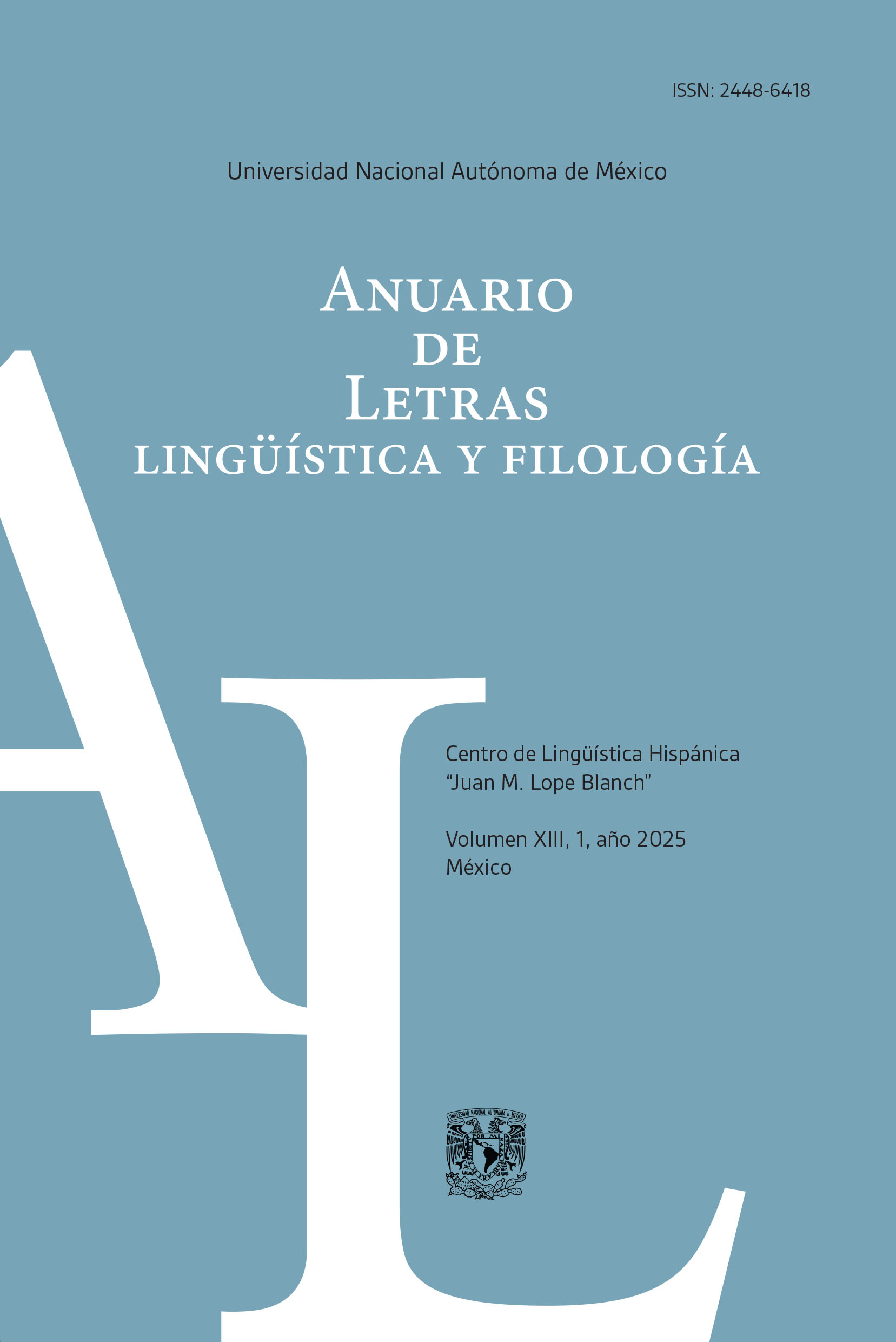Abstract
In the linguistics literature, conque is usually described as an illative conjunction, that is, a conjunction that indicates “that the sentence that follows is a consequence investigate its meaning in contemporary Mexican Spanish. The hypothesis is that it has a mirative value, specifically the type that Aikhenvald (2012) would call “new information for the speaker,” which can be accompanied by other mirative nuances such as “surprise” and “sudden discovery.” or conclusion of the preceding one” (DEM). The aims of this paper are to show, based on the analysis of a corpus of contemporary Mexican Spanish compiled for this study with data from 1975-2004, that conque no longer has this usage, and to investigate its meaning in contemporary Mexican Spanish. The hypothesis is that it has a mirative value, specifically the type that Aikhenvald (2012) would call “new information for the speaker,” which can be accompanied by other mirative nuances such as “surprise” and “sudden discovery.”
References
Álvarez, A. (1999). Las construcciones consecutivas. En I. Bosque y V.
Demonte (eds.), Gramática Descriptiva de la Lengua Española, Vol.
III (pp. 3739-3803). Espasa.
Aikhenvald, A. (2004). Evidentiality. Oxford University Press.
Aikhenvald, A. (2006). Evidentiality in Grammar. En K. Brown (Ed.), Encyclopedia of Language and Linguistics. 2a. ed. (pp. 320-325). Elsevier.
Aikhenvald, A. (2012). The essence of mirativity. Linguistic Typology, 16, 435-485.
Aikhenvald, A. (2018). Evidentiality: The Framework. En A. Aikhenvald (Ed.), The Oxford Handbook of Evidentiality. Oxford Handbooks. https://www.academia.edu/64346715/The_Oxford_Handbook_of_Evidentiality
Boas, F. (1911). Introduction to Handbook of American Indian Languages. En P. Holder (1966) (Ed.), Franz Boas Introduction to Handbook of American Indian Languages & J. W. Powell Indian Linguistic Families of America North of Mexico (pp. 1-79). University of Nebraska Press.
Boye, K. (2018). Evidentiality: The notion and the term. En A. Aikhenvald (Ed.), The Oxford Handbook of Evidentiality. Oxford Handbooks. https://www.academia.edu/64346715/The_Oxford_Handbook_of_Evidentiality
De Haan, F. (2012). Evidentiality and mirativity. En R. Binnick (ed.), The Oxford Handbook of Tense and Aspect (pp. 1026-1046). Oxford University Press.
DeLancey, S. (1997). Mirativity: The grammatical marking of unexpected information. Linguistic Typology, 1, 33-52.
DeLancey, S. (2001). The mirative and evidentiality. Journal of Pragmatics, 33, 369-382.
DeLancey, S. (2012). Still mirative after all these years. Linguistic Typology, 16, 529-564.
De Smet, H. y Verstraete J. C. (2006). Coming to terms with subjectivity. Cognitive Linguistics, 17(3), 365-392.
DEA (2023). Diccionario del español actual. Seco, M., Olimpia A. y G. Ramos. https://www.fbbva.es/diccionario/ [4 de marzo de 2024].
DEM. Diccionario del Español de México. El Colegio de México. http://dem.colmex.mx [18 de abril de 2023].
Diccionario panhispánico de dudas (2005). Real Academia Española y Asociaciónde Academias de la Lengua Española. Santillana.
Diccionario de uso del español de América y España (2002). Lucena Cayuela, N. (Dir.) Vox.
DRAE (2001). Diccionario de la lengua española. Real Academia Española. 22.ª ed. Espasa.
Girón Alconchel, J. L. (2004). Gramaticalización de los marcadores deldiscurso e historia de conque. Lexis, XXVIII, 1-2, 157-198.
Nueva Gramática de la Lengua Española (2009). Real Academia Española y Asociación de Academias de la Lengua Española. Espasa.
Rodríguez Ramalle, T. (2015). Evidentiality and illative markers in Spanish, Journal of Pragmatics, 85, 200-211.
Willet, T. (1988). A crosslinguistic survey of the grammaticalization of evidentiality, Studies in Language, 12, 51-97.
Corpus CEM II. Corpus del Español Mexicano Contemporáneo II [Base de datos]. https://cemc.colmex.mx/ [Consultado en mayo de 2023].
CREA. Corpus de Referencia del Español Actual [Base de datos]. Real Academia Española. https://corpus.rae.es/creanet.html [Consultado en julio de 2021].
Otras fuentes del corpus
Fuentes, C. (1975). Terra nostra. Joaquín Mortiz.
Garro, E. (1991). Y Matarazo no llamó. En G. Beltrán Felix (comp.)
Garro, E. (2016). Elena Garro. Novelas escogidas (1981-1998). Fondo de Cultura Económica.
Mendoza, E. (1999). Un asesino solitario. Tusquets Editores.
Sainz, G. (1977). Compadre Lobo. Grijalbo.

This work is licensed under a Creative Commons Attribution-NonCommercial-ShareAlike 4.0 International License.
Copyright (c) 2024 Anuario de Letras. Lingüística y Filología


